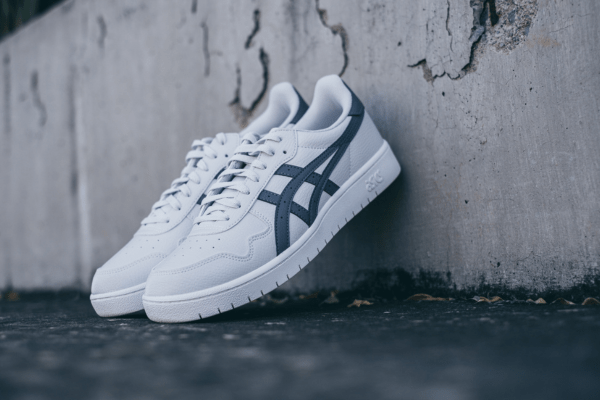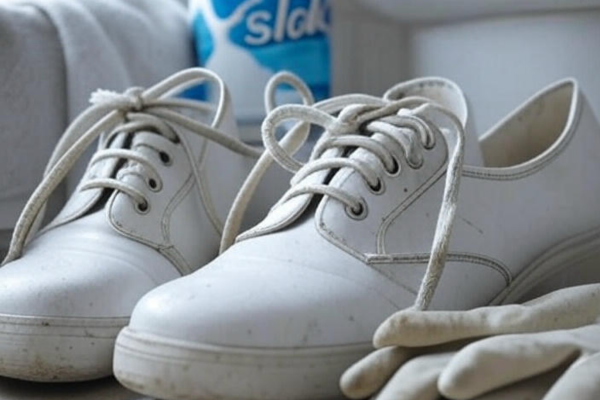1. Introduction
When your shoelaces start looking dirty, stained, or yellowed, replacing them might seem like the only option. But did you know one of the most surprising ways to clean shoelaces at home involves something you already have—toothpaste?
While many people turn to bleach or specialized cleaners, toothpaste offers a simple, safe, and budget-friendly alternative. It’s gentle on fabric, easy to use, and surprisingly effective.
That brings us to the big question:
Can You Clean Shoelaces with Toothpaste?
Yes—and in this guide, we’ll show you exactly how.
From materials and step-by-step instructions to real-life results and expert tips, you’ll learn everything about using the toothpaste shoelace cleaning method to refresh your laces without harsh chemicals.
2. Why Use Toothpaste to Clean Shoelaces?
Is it possible to clean shoelaces using toothpaste? —the answer is yes, and there are some solid reasons why this simple household item works surprisingly well. Let’s break it down:
1. Whitening Properties
Toothpaste—especially white, non-gel varieties—contains mild abrasives and gentle whitening agents like baking soda or hydrogen peroxide. These ingredients help lift dirt, stains, and yellowing from white shoelaces without damaging the fabric. It’s a quick fix for restoring that fresh, clean look.
2. Gentle on Fabric
Unlike bleach or harsh detergents, toothpaste is non-corrosive and gentle, making it safe for delicate lace materials like cotton or polyester. You won’t have to worry about weakening the fibers or fading colors (if tested first on colored laces).
3. Easily Available and Budget-Friendly
Almost everyone has toothpaste at home, making it a cost-effective and convenient option. You don’t need to buy special shoe cleaners or fabric treatments—just grab your toothbrush and you’re good to go.
4. Perfect for Spot Cleaning
When your shoelaces have small stains or marks, you don’t always need a full wash. Toothpaste is ideal for spot cleaning, especially when you’re in a hurry. Just dab it on, scrub gently, rinse, and your laces will look noticeably better.
To sum it up, cleaning shoelaces with toothpaste is a smart, safe, and efficient method for keeping them looking fresh. It’s perfect for quick cleanups and requires minimal effort or expense.
3. What Types of Shoelaces Can Be Cleaned with Toothpaste?
If you’re exploring the toothpaste shoelace cleaning method, it’s important to know which types of laces respond best to this technique. While the method is safe and effective for many materials, it’s not universal.
Best Materials for Toothpaste Cleaning
The toothpaste method for cleaning laces works especially well on:
- Cotton shoelaces—soft, absorbent, and easy to scrub
- Canvas laces—Durable and can handle gentle abrasives
- Polyester shoelaces, often found in athletic footwear, tend to clean up nicely with non-gel toothpaste.
These materials can tolerate the light scrubbing and whitening agents found in toothpaste, making them ideal candidates for at-home cleaning.
Materials to Avoid
Not all shoelaces are suitable for this method. Avoid using toothpaste on:
- Silk or satin laces—too delicate for scrubbing or abrasive pastes
- Leather laces—Can dry out or crack when exposed to toothpaste
- Heavily dyed or colored laces—The whitening agents may cause fading or discoloration.
For such materials, it’s safer to use mild soap and water or a fabric-specific cleaner.ner.
White vs. Colored Shoelaces
The toothpaste method for cleaning shoelaces is most effective on white shoelaces, especially when you’re aiming to remove yellowing or stubborn stains. That’s because toothpaste—particularly non-gel white toothpaste—contains mild bleaching agents.
Wondering why non-gel toothpaste works best on shoelaces? It’s because gel-based toothpaste often lacks the mild abrasives and whitening ingredients (like baking soda or hydrogen peroxide) that help lift dirt and brighten fabric. Always choose a plain white, non-gel toothpaste for the best results.
For colored shoelaces, always test a small, hidden area first to avoid any color loss or fading.
In short, can you clean shoelaces with toothpaste? Yes—but only certain materials. Stick to cotton, canvas, and polyester for best results, and always choose non-gel toothpaste for safe and effective lace cleaning.
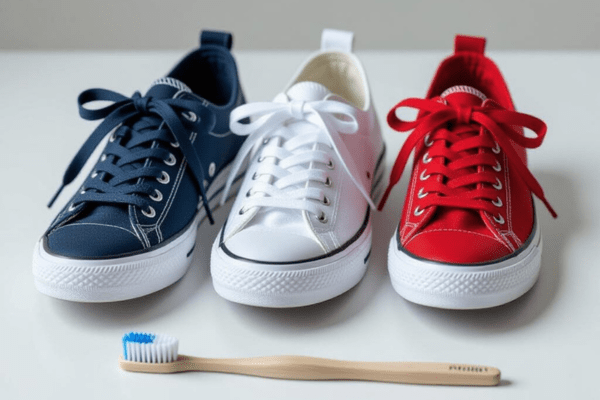
4. Step-by-Step Guide: How to Clean Shoelaces with Toothpaste
Looking for quick fixes for dirty laces? One of the simplest and most effective methods is using something you already have at home: toothpaste. Whether you want to clean laces without bleach or simply freshen up your sneakers, this easy routine gets the job done.
Here’s a step-by-step guide using the toothpaste shoelace cleaning method:
What You’ll Need:
- White non-gel toothpaste (avoid colored or gel-based varieties)
- Old toothbrush (soft-bristled works best)
- Bowl of water (lukewarm preferred)
- Towel (for drying and protecting surfaces)
Instructions:
- Remove shoelaces from shoes
Take out the laces to clean them properly and avoid staining your shoes. - Wet the laces slightly
Slightly moisten them with fresh water to enhance the toothpaste’s spread and foaming action. - Apply toothpaste directly on stains
Use white non-gel toothpaste for best results. Focus on visibly dirty spots or yellowed areas. - Scrub with a toothbrush
Gently scrub in circular motions. This helps remove stains from shoelaces with toothpaste without damaging the fabric. - Let sit for 10–15 minutes
Allow the toothpaste to penetrate and lift dirt, especially for older or stubborn stains. - Rinse thoroughly with clean water.
Wash off all the toothpaste. Ensure no residue is left behind, as it can stiffen the laces once dry. - Air dry completely
Lay the laces on a clean towel and let them air dry naturally. Steer clear of using dryers to avoid shrinking or heat-related damage.
Using this toothpaste method for cleaning laces is a practical solution for those who want to clean shoelaces without bleach. It’s quick, safe, and budget-friendly—perfect for everyday care.
So the next time you notice grime building up, remember this simple routine to refresh your laces using toothpaste in just a few easy steps.
5. Toothpaste vs. Other Cleaning Methods
If you’ve ever asked yourself, “Can you clean shoelaces with ”toothpaste?”—the answer is yes. But how does it compare to other popular methods like baking soda, bleach, or hydrogen peroxide?
Let’s explore how cleaning dirty laces with toothpaste holds up against other common cleaning agents and when it’s the best option to use.
Toothpaste vs. Baking Soda
Similarities:
- Both are mild abrasives that help remove dirt and stains.
- Both are non-toxic and safe for most fabrics.
- Both are readily available in most homes.
Differences:
- Toothpaste is easier to apply directly and often contains extra whitening agents, like hydrogen peroxide.
- Baking soda needs to be mixed with water or vinegar to create a paste.
Use toothpaste when you need a quick, pre-mixed solution for light stains or touch-ups.
Toothpaste vs. Bleach
- Strong whitening power for heavily stained white laces
- Can damage or weaken fabric fibers
- Unsafe for colored laces
Toothpaste:
- Much gentler on fabric
- Ideal for fabric laces like cotton and polyester
- Safe for spot cleaning and quick fixes
Is toothpaste safe for cleaning fabric laces?
Yes—unlike bleach, toothpaste is fabric-safe when used properly and doesn’t cause yellowing or brittleness.
Choose toothpaste over bleach if you’re cleaning delicate or colored laces and want to avoid damage.
Toothpaste vs. Hydrogen Peroxide
- Effective stain remover and whitening agent
- Often used in combination with baking soda
- Can be harsh on darker fabrics or synthetic materials
Toothpaste:
- Contains controlled amounts of peroxide (in whitening formulas)
- Easier to use, less likely to over-whiten or cause fabric discoloration
Use toothpaste when you want gentle yet effective whitening, especially for white shoelaces.
When Should You Use Toothpaste Over Other Methods?
- When you need a quick, no-mess solution
- When you’re spot-cleaning fabric laces
- If you’re looking to steer clear of strong chemicals such as bleach.
- When you’re unsure if your lace material can tolerate baking soda or peroxide
Overall, cleaning dirty laces with toothpaste is a practical and safe method that works well for most everyday situations. It’s gentle, affordable, and surprisingly effective.
So, can you clean shoelaces with toothpaste? Absolutely—and it’s often the smartest choice when dealing with fabric laces that need a safe, efficient refresh.
6. Tips for Best Results
Using toothpaste for fabric stain removal is an easy and budget-friendly method, but to get the best outcome, a few smart tips can make a big difference. If you’re doing a DIY shoelace cleaning with toothpaste, follow these expert-backed suggestions to avoid common mistakes and boost effectiveness.
1. Use White Toothpaste Only (No Colored Gel)
Always use plain white, non-gel toothpaste. Why? Because gel or colored toothpaste often lacks the mild abrasives and whitening ingredients (like baking soda or hydrogen peroxide) that help break down stains.
White toothpaste is safer, more effective, and won’t leave behind any unwanted colors or residue on your shoelaces.
2. Spot Test Colored Laces First
Before applying toothpaste to colored or dyed shoelaces, always perform a spot test on a hidden area. Some whitening toothpastes may cause slight fading, especially on dark or delicate fabrics.
This quick test ensures your DIY shoelace cleaning with toothpaste won’t accidentally alter the color of your laces.
3. Combine with Baking Soda for Extra Whitening Power
For heavily stained or yellowed white laces, you can mix white toothpaste with a small amount of baking soda. This creates a powerful, yet fabric-safe paste that tackles deeper stains.
This combo works well when using toothpaste for fabric stain removal, especially on cotton or polyester shoelaces.
4. Don’t Over-Scrub Fragile Laces
While toothpaste is gentle, excessive scrubbing with a hard toothbrush can damage thin or delicate lace fabrics. Opt for a soft-bristled brush and clean using light, circular strokes.
Take extra care with old or fraying laces to avoid tearing the fibers.
Bonus Tip: Let the Toothpaste Sit for a Few Minutes
Once you’ve finished scrubbing, allow the toothpaste to rest on the stain for 10–15 minutes before rinsing it off. This gives the active ingredients time to lift dirt and grime effectively.
With these simple but effective tips, your toothpaste shoelace cleaning method will deliver the best possible results—clean, fresh laces without harsh chemicals or expensive products.
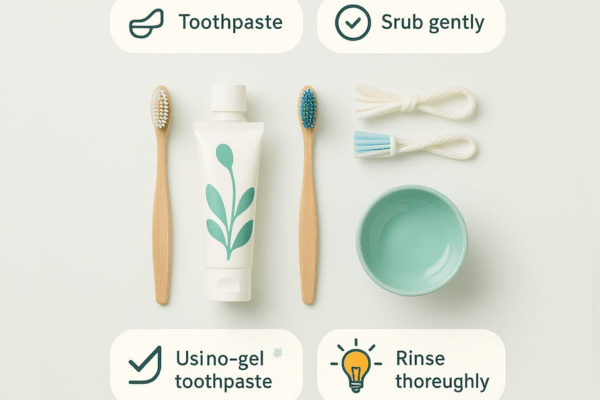
7. Common Mistakes to Avoid
When it comes to quick fixes for dirty laces, using toothpaste is a popular and effective solution. But to get the best results—and avoid damaging your laces—it’s important to steer clear of a few common mistakes.
If you’re trying DIY cleaning hacks for sneakers and sports shoes, keep these errors in mind:
1. Using Gel Toothpaste
Not all toothpaste is created equal. Gel toothpaste often lacks the mild abrasives and whitening ingredients needed for effective stain removal. Colored gels can also leave behind unwanted tints on white or light-colored laces.
Use plain white, non-gel toothpaste for the safest and most reliable results.
2. Not Rinsing Thoroughly
One of the biggest mistakes is leaving toothpaste residue on your shoelaces. If not rinsed properly, the paste can stiffen the fabric, attract more dirt, or even cause skin irritation.
After scrubbing, always rinse laces under cool, clean water until all residue is completely gone.
3. Using Hot Water on Synthetic Laces
Hot water may seem like a good idea, but it can damage synthetic materials like nylon or polyester by causing them to shrink or lose elasticity.
For best results, stick to lukewarm or cool water when cleaning any type of shoelace.
4. Ignoring the Fabric Type
Different materials react differently to toothpaste. For example, cotton and polyester laces handle the toothpaste method well, but delicate materials like silk or leather may get damaged.
Always check the lace material and use gentler methods if needed. When in doubt, perform a spot test first.
By avoiding these simple mistakes, your toothpaste shoelace cleaning method will work better, last longer, and give your shoes a fresher, cleaner look—without causing any damage.
For more cleaning hacks for sneakers and sports shoes, explore our other guides and keep your kicks looking brand new.
8. Real-Life Results: Before & After
If you’ve ever wondered, “Can you clean shoelaces with toothpaste?”—it’s not just about the method; the true value lies in the real-world results. Below, we’ve shared actual examples and feedback to show just how effective the toothpaste shoelace cleaning method can be.
Before & After: Visual Proof
To truly understand the power of cleaning dirty laces with toothpaste, see the difference for yourself:
- Before: Shoelaces were stained with mud, sweat buildup, and yellowing from daily wear.
- After: Brightened, stain-free laces that look nearly new—with no use of bleach or harsh chemicals.
This method works especially well on white cotton and polyester laces, making it one of the best DIY shoelace cleaning techniques for those looking for a fast, affordable solution.
Real User Experience
“I used non-gel white toothpaste and an old toothbrush on my son’s soccer shoe laces. I let it sit for 15 minutes and rinsed it with cold water. The results were amazing—90% of the stains were gone without any bleach! I’ll definitely use this again.”
This testimonial reflects the growing popularity of using toothpaste for fabric stain removal, especially among those looking for quick fixes for dirty laces that don’t involve soaking, bleaching, or expensive cleaners.r quick fixes for dirty laces that don’t involve soaking, bleaching, or expensive cleaners.
Why It Works
- The mild abrasives in white toothpaste lift dirt gently.
- Works well on everyday sneaker and sports shoe laces
- Perfect for on-the-go spot cleaning or deep cleaning sessions
- Safe for most common lace materials like cotton and polyester
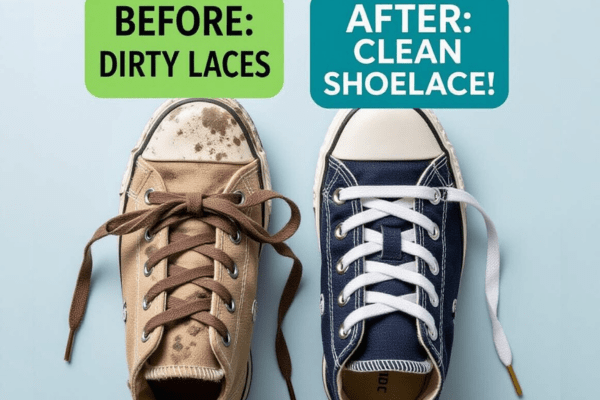
9. Conclusion
To wrap it up, if you’ve ever asked yourself, “Can you clean shoelaces with toothpaste?”—now ”you know the answer is a clear yes. This simple household item offers a range of benefits:
- Gentle on fabric—safe for cotton, canvas, and polyester
- Budget-friendly—no need for expensive cleaners
- Effective stain remover—especially for white laces
- Quick and easy—ideal for everyday cleaning or last-minute fixes
The toothpaste shoelace cleaning method is one of the best DIY shoelace cleaning options out there. Whether you’re removing mud stains, yellowing, or everyday dirt, toothpaste proves to be a safe, effective, and convenient solution for most types of laces.
Try it yourself! Use this step-by-step method on your dirty laces and see the difference. And if you found this helpful, explore more lace-cleaning tips, methods, and sneaker care guides right here on our blog.
10. FAQs
1. Can you leave toothpaste on shoelaces overnight?
Leaving toothpaste on shoelaces overnight is generally not advised. While toothpaste is safe for fabric in short applications, extended exposure may dry out or stiffen the fibers, especially if the laces are made of cotton or synthetic materials. For best results, let the toothpaste sit for 10–15 minutes, then rinse thoroughly.
2. Does toothpaste damage colored laces?
Toothpaste can sometimes cause fading or discoloration on dyed or dark-colored laces, especially if it contains whitening agents like hydrogen peroxide. Always do a spot test on a hidden section before applying it all over. When cleaning colored shoelaces, opt for a mild, non-whitening toothpaste to minimize the chance of discoloration or damage.
3. Which toothpaste works best?
When using toothpaste to clean shoelaces, be sure to select white, non-gel varieties only. This type typically contains mild abrasives and cleaning agents like baking soda or peroxide that help remove stains and whiten fabric. Avoid colored or gel-based toothpaste, as they lack the cleaning power and may leave behind unwanted residue.
4. Is it safe to combine toothpaste with vinegar or baking soda?
Yes, combining toothpaste with baking soda is possible and can boost whitening effectiveness. This combo works great for cleaning dirty laces with tough stains or yellowing. However, avoid mixing toothpaste with vinegar, as the reaction may create excessive foaming and reduce cleaning effectiveness. For optimal outcomes, use only one technique at a time.

